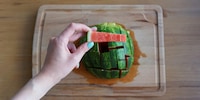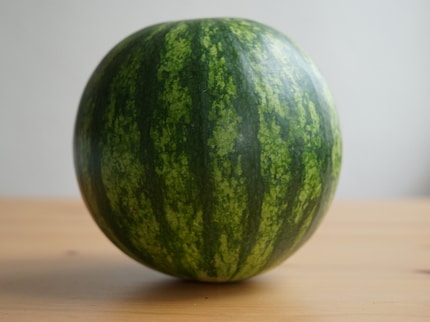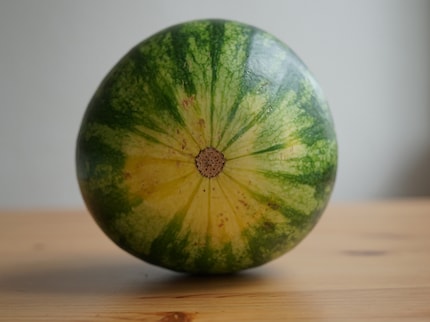
Guide
The right way to cut watermelon
by Livia Gamper

Sound, markings or stem? Here’s what to look out for when picking out the perfect watermelon.
You’ve just lugged home a four-kilo watermelon in over 30-degree heat. Full of anticipation, you cut it open and take the first bite... only to find that though it tastes like water, it doesn’t taste at all like melon. Looking out for these 5 characteristics will spare you the disappointment of this scenario in the future.
The easiest method is to look at the watermelon’s skin. If it’s a strong, matt green, it’s a good sign.
On the other hand, if the skin is shiny, the watermelon might not be quite ripe yet – and will taste less sweet and juicy as a result. Plus, if a melon is an overly light green, it’s an indication you should steer clear.

The brown, web-like patterns on a watermelon are a sign the fruit is sweet and ripe – even it isn’t considered the most reliable indicator. In fact, the spots show the melon has ripened well. They demonstrate that bees visited the flowers of the fruit more often than others, and that they were pollinated as a result.
You should also look out for the field spot, a large, yellow patch on the bottom of the melon. This is where the melon ripened when it was still in the field. The more visible this stain, the longer the fruit was probably left lying on the field in the sunshine. If it doesn’t have a field spot, or if it’s whitish rather than yellow, it’s very likely the melon isn’t ripe yet.

After that, there’s still the stem left to examine. It’s meant to be brown. A green stem tends to indicate that the watermelon was harvested too early, meaning it’s not yet ripe and sweet.
This point is probably the most controversial. Opinions are divided as to whether the knock test is actually of any use, or just a waste of time. A number of people maintain that if the melon sounds dull and deep, it’s better. Since I’d feel silly standing in the supermarket with my ear pressed against a melon anyway, I don’t bother checking for this characteristic. The other four methods are enough for me.
By the way, you’re supposed to store watermelon, which is actually a vegetable (article in German), at room temperature. It doesn’t go in the fridge until it’s been cut up. Also, feta with watermelon and peppermint is the queen of summer salads (recipe in German). And barbecued watermelon is exquisite too!
Header image: Livia Gamper
Testing devices and gadgets is my thing. Some experiments lead to interesting insights, others to demolished phones. I’m hooked on series and can’t imagine life without Netflix. In summer, you’ll find me soaking up the sun by the lake or at a music festival.
Practical solutions for everyday problems with technology, household hacks and much more.
Show all